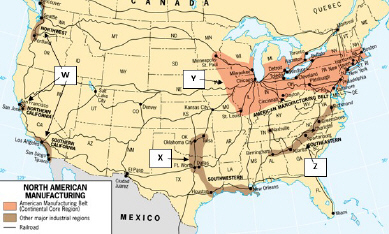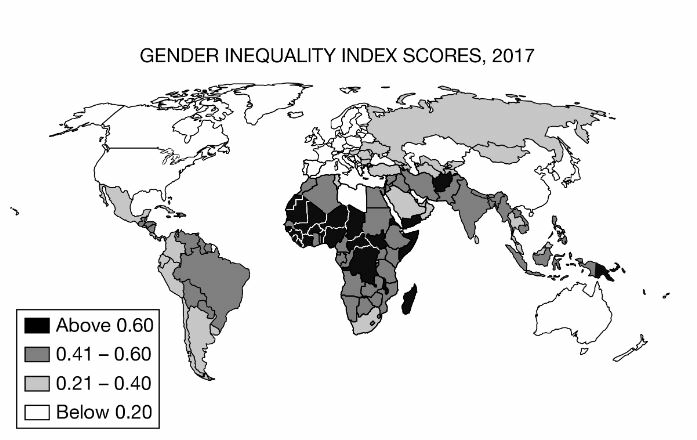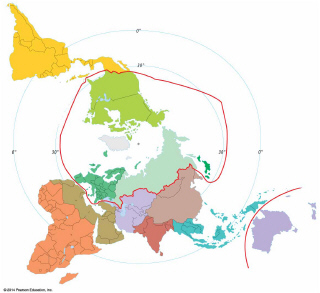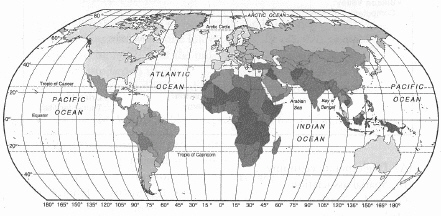Unit 7 APHUG
1/29
There's no tags or description
Looks like no tags are added yet.
Name | Mastery | Learn | Test | Matching | Spaced |
|---|
No study sessions yet.
30 Terms
The biggest problem in promoting development through the international trade alternative is:
a. consumer demand expanding faster than manufacturing can increase
b. regional cooperation
c. increased price of petroleum
d. unequal distribution of resources
e. increased demand for many goods
d
Significant site factors include all of the following EXCEPT:
a.
natural resources and space to build (land)
b.
access to machinery and equipment (capital)
c.
people who can work in the occupation (labor)
d.
transportation systems to move inputs and products
e.
all factors listed are site factors
d
The secondary sector of the economy includes which of the following?
a.
data processing and IT
b. government
c.
construction and manufacturing
d.
banking and finances
e.
mining and fishing
c
The higher gross domestic product per capita in some less developed countries such as Brazil, South Africa, and Malaysia is best explained by increases in the value of the country’s
a. women-owned business and microloan programs
b. agricultural land development and the number of farmers
c.
manufacturing output and service industry employment
d.
textile and clothing manufacturing
e. foreign aid payments and food aid from other countries
c

According to the map below, the primary industrial activity in region W is:
a.
petroleum refining.
b.
agricultural product processing.
c.
textiles.
d.
heavy manufacturing including steel and auto production.
e.
high technology goods.
e
Which of the following statements correctly explains the rapid growth of the Four Dragons?
a. By connecting their economies with one other country, they were able to finance development through trade with China.
b. By cutting off their economies from global competition and interaction, the Asian Dragons were able to develop through the self-sufficiency approach.
c. They were able to pay for development through a series of loans from the International Monetary Fund.
d.
These countries were able to take advantage of cheap labor costs in order to produce high-quality, low cost items for sale on world markets.
e. The sale of an abundant, valued, natural resource allowed these countries to finance development.
d

In a number of countries there remains significant inequality between men and women. Based on a comparison of the patterns on the map, which of the following statements draws an accurate conclusion?
a. Women in Russia have more equality with men than do women in China.
b. Women in India have more equality with men than do women in other Asian countries.
c. Women in South Africa have less equality with men than do women in Brazil.
d. Women in Libya have more equality with men than do women in other African countries.
e. Women in Australia have less equality with men than do women in China.
d
In contrast to Fordist production, Post-Fordist production is more likely to:
a.
require larger inventories of parts and components.
b.
include repetitive tasks.
c.
assign each worker one task.
d.
pay each worker the lowest wage possible.
e.
rely on well-educated workers to creatively solve problems.
e
Which indicator of gender equality would be higher in sub-Saharan Africa than in developed countries?
a. the percentage of seats held by women in national legislatures
b. the female labor force participation
c. the adolescent fertility rate
d. the percentage of women completing high school
e. the maternal mortality ratio
b

The map shown above best illustrates the concept of:
a. agglomeration economies
b. core-periphery theory
c. energy consumption
d. the technology gap
e. neocolonialism
b
Since 1990, most countries have seen decrease in which of the following?
a. the amount of workers in the tertiary sector
b. per capita GNI
c. their HDI score
d. gender inequality
e. gender equality
d
In which of the following ways has industry within the United States shifted in the last few decades?
a.
Employment has shifted back to the primary sector as a result of the green revolution.
b.
The Northeastern U.S. has lost manufacturing jobs while the South and West gained manufacturing jobs.
c.
The United States has become a destination for foreign manufacturing.
d.
Right-to-work laws have driven manufacturing jobs into the Northeastern portion of the United States.
e.
Industry has become more concentrated in the Rust Belt.
b
The reason for the concentration of copper smelters, refineries, and foundries close to Arizona's copper mines is that copper production is
a. oriented to the large Southern California market
b. dependent on dry climate conditions
c. a bulk-gaining industry
d. a bulk-reducing industry
e. attracted to low-cost migrant labor
d
Which of the following scenarios is best explained by the increasing global popularity of ecotourism?
a.
The increased use of snowmobiles, aircraft, and off-road vehicles by tour companies in Alaska as people seek to experience more remote locations to view wildlife
b.
The expansion of luxury resorts owned by multinational hotel companies along Thai and Indonesian beaches that is based on tourists’ attraction to tropical locations
c.
The high traffic and congestion at sites like Yellowstone National Park due to tourists’ increased desire to experience the outdoors
d.
The development of small, locally owned lodges near ecological preserves in the Brazilian Amazon due to tourists’ desire to benefit the local economy and minimize their environmental impact
e.
The expansion of cruise experiences that take passengers to multiple Caribbean and Central American countries because of tourists’ desire to experience a variety of global cultures
d
Saudi Arabia has successfully employed the international trade alternative primarily because of:
a. regional cooperation
b. its strategic distribution location
c. petroleum reserves
d. consumer spending
e. low-cost manufacturing
c
Industrial areas first developed
a. near airports.
b. in urban areas with large populations.
c. on vast open plains.
d. Interior areas near markets.
e. along rivers and coastal areas.
e
Which of the following best explains a political-economic weakness or limitation of Rostow’s stages of economic growth?
a.
The model does not hold up to modern times because essentially all countries around the world have moved through Rostow’s stages of economic growth as expected.
b.
Rostow made the inaccurate assumption that all countries want modernization as defined in the model and would pass through the outlined stages in order.
c.
According to Rostow, countries will become less dependent on the sales of their commodities as they advance.
d.
Some critics claim commodities were exchanged between core and periphery areas well before modern times.
e.
The stages as defined by Rostow are not useful because sustainability is not addressed.
b
The port of Los Angeles is the busiest port in the United States and a major break-of-bulk point. Which of the following statements correctly explains why Los Angeles is a break-of-bulk point?
a. Los Angeles is on the Pacific Ocean allowing for more trade with countries in Asia and is a hub for textiles.
b. The port can accomodate large container ships that can be unloaded quickly so that containers can be transferred onto carriers that use California's highway and rail systems.
c. Goods can be transferred to other container ships going to the port of San Francisco.
d. The robotic systems at the port results in fewer workers being required to unload container ships.
e. The massive warehouses located at the port allow goods from container ships to be stored easily and for long periods of time.
b
The principal benefit on the self-sufficiency approach is to promote:
a. balanced growth in all economic sectors
b. unequal distribution of resources
c. international trade
d. global competitiveness for local industries
e. the maintenance of a large bureaucracy
a

Compare the two images. What do the technologies shown demonstrate about the Industrial Revolution?
a. The initial take-off stages of the Industrial Revolution focused solely on heavy, material-oriented industries.
b. The dependence on large quantities of steel has limited industrial growth to areas with high concentration of coal and iron.
c. Due to the cost of such large-scale industrial projects, industrialization has been unable to diffuse to developing countries.
d. Industrial centers must be built along rivers or waterways to facilitate the transportation of raw materials and finished goods.
e. The increased transportation technology has enabled the diffusion and expansion of industrial activities.
e

Which of the following statements is most consistent with the data shown in the table?
a. Spain and Kuwait are countries that have very different levels of economic development.
b. There are a large number of women in the Spanish legislature, but few women have been elected in Kuwait.
c. Spain and Kuwait are countries that have very similar levels of economic and social development.
d. There is a close correlation between the two statistics displayed on the chart above.
e. An increase in per capita wealth will almost always result in an improvement in gender equity in a country.
b
Maquiladoras in northern Mexico are:
a. border favela settlements.
b. illegal migrant labor camps.
c. commercial produce farms.
d. organic agricultural cooperatives.
e. manufacturing outsourcing plants.
e
The new international division of labor reflects the growing importance of:
a.
just-in-time inventory management.
b.
access to raw materials.
c.
vertical integration.
d.
outsourcing.
e.
new infrastructure.
d
Compared with more developed countries, which of the following statements is true of less developed countries?
a.
Population pyramids exhibit narrower bases.
b.
a higher percent of the labor force is engaged in food production.
c.
The per capita consumption of energy is higher.
d.
Fertility rates are lower.
e.
The natural increase of the population is lower.
b
What is development?
a. the process used to aid in a factory’s output
b. the process of improving the material conditions of people through technology and knowledge
c. the process that aids people’s intellectual ability
d. the process of giving children in Africa a free laptop
e. the process of manufacturing efficiently
b
Industries have higher productivity in developed countries because they:
a. have a low amount of value added per person
b.
have employees that work harder
c. need less education to be effective at their jobs
d.
understand the industry better
e. have access to more technology
e

The regions shaded dark on the map above would describe high rates for all of the following indicators of development EXCEPT:
a. literacy rates
b. infectious disease incidence
c. total fertility rates
d. growth rates
e. infant mortality rates
a
A Dr. Pepper bottler will tend to locate near major distribution areas in order to maximize profits because it is a:
a.
specialized manufacturer.
b.
bulk-gaining industry.
c.
Single consumer industry.
d.
bulk-reducing industry.
e.
site factor.
b
Often a manufacturing company will attempt to merge with another company that possesses forward or backward links in the supply or production process. Which of the following terms best describes this type of strategy?
a.
Economies of Scale
b.
Privatization
c.
Vertical integration
d.
Transnational corporation
e.
Agglomeration
c
If the per capita GNI in a given country is about $1,500, this indicates that it is a:
a. more developed country
b. country with a high gross domestic product
c. country with evenly distributed wealth
d. petroleum exporting state
e. less developed country
e